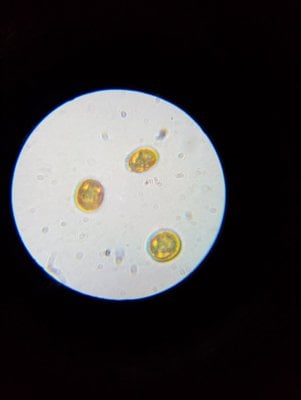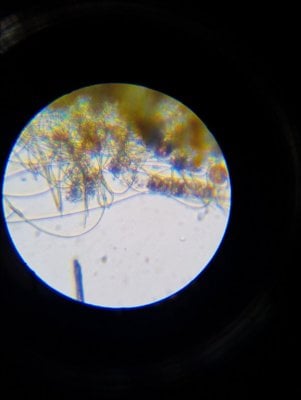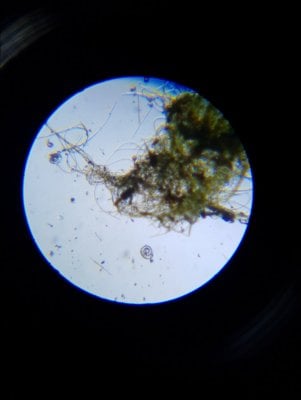BTW, in case anyone missed it, we're stickied on the Algae forum now instead of being a normal thread in the Reef Discussion section. Hopefully this will be a help in reaching more folks!
Navigation
Install the app
How to install the app on iOS
Follow along with the video below to see how to install our site as a web app on your home screen.
Note: This feature may not be available in some browsers.
More options
You are using an out of date browser. It may not display this or other websites correctly.
You should upgrade or use an alternative browser.
You should upgrade or use an alternative browser.
Dinoflagellates – Are You Tired Of Battling Altogether?
- Thread starter mcarroll
- Start date
- Tagged users None
- Joined
- Mar 17, 2017
- Messages
- 845
- Reaction score
- 1,310
What is the recommended UV sterilizer for a 50-65 gallon setup? The ones I saw were upwards of $300 x_x
I used a jebo 36w paired with an maxi jet 400 pump on a reefer 250 - roughly 65 gallons. The Jebo 36w was the cheapest option and I was just testing the waters but I think it helped my tank. It’s too big to go under the sump so will eventually be replaced with a different make that can. Note that jebo doesn’t come with any useful info for flow rate and sterilization dosage. Briefly, high end sterilizer typically come with recommendation for a fast flow rate to kill bacteria, and a slow flow rate to kill bigger things like ick. Too fast a flow rate is not effective (=too light a dose of uv) and too slow is also not effective (= not enough volume passes through the sterilizer)
So
I extrapolated the rate for the jebo based on published flow rates from higher end sterilizer of similar size. Forgot now what the rate is but the MAxi jet 400 does it.
I posted a little update on my battle here
- Joined
- May 22, 2016
- Messages
- 6,970
- Reaction score
- 10,747
If you read my other posts on amphidinium, then you've got a decent idea what you're dealing with. Worst thing about them is no easy way for direct cell removal/killing. Best thing about them is generally low toxicity and staying in the sand bed allows for patience and grazer pods/ciliates/snails etc to help with them.After some research, you've nailed it. I found your other posts regarding them and watched some videos. Looks like I need to up my P dosing and feed a little less. Problem with feeding less is my Midas blenny is turning into a complete jerk and feeding more is the only thing to have calmed him down a little.
I will say I've been lucky that my pod population has been good to great the whole time. Once the lights are out, they are all over the sand. I'm talking hundreds of them all over the place. Sand and rock are crawling with them. The area that gets the Dino patch had at least 20 of them scurrying around just a minute ago.
I would get a fuge going with chaeto but my setup limits me. I am not a huge fan of macro in my display and my sump has no spot for chaeto unless I remove the skimmer. I'd love a new sump but tank money went towards an ATO with the Black Friday deals...
Make the fish happy. You can work around it. (Also different foods have different N/P ratios, you might switch some foods to target tank nutrient needs) I'd also strongly consider slapping a ball of chaeto on the sand at the site of outbreak. You can easily pull it later when the brown subsides.
It does seem likely that this is also amphidinium, but can you get a video of movement? Or check the vids on algaeid.com and compare.Hey rtparty. I saw those pics with all the stuff mixed in and saw a few things that look like mine. I started dosing Nitrate and Phosphate again and have a UV on the way. Good luck with your battle.
A quick update.
Dosing 5ml of phosphate daily for a few weeks now. Phosphate reading 0.03 and nitrate coming down at at about 10.
I was away for a couple of days and here are some pics. I am coming to a realisation that I dont have enough clean-up crew.
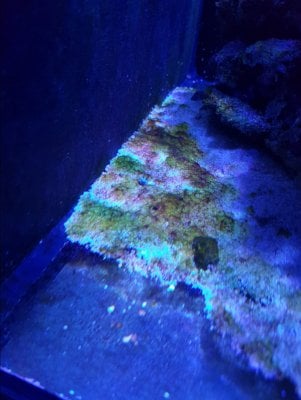
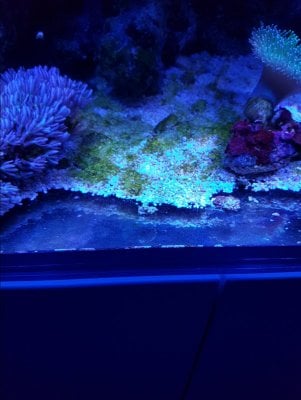
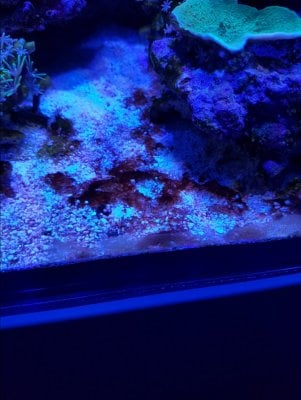
What I am seeing at the moment is areas that were typical Dino areas are now getting taken over by a green algae. Also the rocks surfaces that do not have coraline algae are growing a lot of algae. The corals never looked better.
I need to increase my cleanup crew to get this new algae in control.
Should I get rid of my sandshifting starfish? I read that they can take out benficial stuff from the sand.
Dosing 5ml of phosphate daily for a few weeks now. Phosphate reading 0.03 and nitrate coming down at at about 10.
I was away for a couple of days and here are some pics. I am coming to a realisation that I dont have enough clean-up crew.



What I am seeing at the moment is areas that were typical Dino areas are now getting taken over by a green algae. Also the rocks surfaces that do not have coraline algae are growing a lot of algae. The corals never looked better.
I need to increase my cleanup crew to get this new algae in control.
Should I get rid of my sandshifting starfish? I read that they can take out benficial stuff from the sand.
- Joined
- May 22, 2016
- Messages
- 6,970
- Reaction score
- 10,747
Yep, I would remove the sand sifter starfish. It's a predator, not a grazer.
And I totally agree with the need for more grazers. People say "clean up crew" and that encompasses the scavengers, but it's the herbivores that are most needed.
And I totally agree with the need for more grazers. People say "clean up crew" and that encompasses the scavengers, but it's the herbivores that are most needed.
What I am seeing at the moment is areas that were typical Dino areas are now getting taken over by a green algae. Also the rocks surfaces that do not have coraline algae are growing a lot of algae. The corals never looked better.
I need to increase my cleanup crew to get this new algae in control.
Great news overall!!
Is it just the weird colors or does it also look like maroon cyano is starting to take over in those spots too? (This is also good. Just curious.)
I agree on the CUC, but I would only introduce a small number if there's any question whether there are still toxins begin generated. See how a small group does for a week or so before adding the main force upgrade.
Great news overall!!
Is it just the weird colors or does it also look like maroon cyano is starting to take over in those spots too? (This is also good. Just curious.)
I will take some samples today and get them under the microscope.
I should have said the 1st photo is from the red colour patch on the previous post. The second 2 photos are from the green area on the sand.Here are some photos. There are still Dinos. But a lot more other life evident too.
In the past all I would have seen are Dinos.
Still trying to get caught up, but here is the best pic I can get of my dinos at the moment. If someone could help me with ID I can read and figure out the rest. I can supply any other information if needed. Very interesting thread so far.

right off that bat those look too large to be dinos? T there are strains with cells so big we don't need scopes? golden planaria 1st guess but maybe its large cell dinos/wow
- Joined
- Nov 22, 2017
- Messages
- 14
- Reaction score
- 3
Hey guys, few questions on the microscope, should I just be looking at a sample of water?
I tried to get a piece of the brown algae and got the attached pictures as best I could. (Nothing was moving in the water as I've seen a lot of things moving in people's videos. However this was room temperature water). Any thoughts? Tips?


I tried to get a piece of the brown algae and got the attached pictures as best I could. (Nothing was moving in the water as I've seen a lot of things moving in people's videos. However this was room temperature water). Any thoughts? Tips?


Is it between two slides. Depends on room temp. They can slow down as the water gets colder. We keep our house at 68 in the winter. Central Il it’s a heck of a lot warmer than the air temp. 
- Joined
- Nov 22, 2017
- Messages
- 14
- Reaction score
- 3
It's usually at about 70° in the office. It was not between two slides it was actually a droplet of water with the specimen in it.
most are smaller than diatoms and are marine plankton. I don’t think the ones in our tank are big enough to See individuals with out a microscopeStill trying to get caught up, but here is the best pic I can get of my dinos at the moment. If someone could help me with ID I can read and figure out the rest. I can supply any other information if needed. Very interesting thread so far.

It may have sat too long. Best form fresh sample.It's usually at about 70° in the office. It was not between two slides it was actually a droplet of water with the specimen in it.
- Joined
- Nov 22, 2017
- Messages
- 14
- Reaction score
- 3
Just did that. I think I found a patch of cyano which I grabbed in this first attachment.It may have sat too long. Best form fresh sample.
And judging on the second picture which I am more positive is the brownish slime that attracts bubbles during the day, I don't think I have dinos.


So, guys ...
I have read here and there that some macroalgae, in this case the algae Ulva pertussa and Gracilaria lemaneiformes, in nature would have a devastating effect on DINOFLAGELADOS TOXIC, causing "flowering", through allelopathic inhibition ...
For those who do not remember, I remember here that it is a distant effect from some chemical catabolites that some species of microbes, algae, plants and corals naturally eliminate in their environment, without any "intention" in this, it is obvious, but that even without intention ends up producing effects that somehow favor them in competitive terms, inhibiting or eliminating the "competitors" in their niche and, with this, managing to survive or dominate over other species in control of that site.
In the present case, and considering aquarism, perhaps the maintenance of some of these species in a refuge, as we already do, for example, with Chaetomorpha linum to obtain nutrient control, could have, besides the control of nutrients (by consumption and export), also this pleasant "side effect" of controlling this pest, which from time to time installs in our reef aquariums.
It's just an idea ... but who knows?
http://www.sciencedirect.com/science/article/pii/S0304377006001410
Best regards
I have read here and there that some macroalgae, in this case the algae Ulva pertussa and Gracilaria lemaneiformes, in nature would have a devastating effect on DINOFLAGELADOS TOXIC, causing "flowering", through allelopathic inhibition ...
For those who do not remember, I remember here that it is a distant effect from some chemical catabolites that some species of microbes, algae, plants and corals naturally eliminate in their environment, without any "intention" in this, it is obvious, but that even without intention ends up producing effects that somehow favor them in competitive terms, inhibiting or eliminating the "competitors" in their niche and, with this, managing to survive or dominate over other species in control of that site.
In the present case, and considering aquarism, perhaps the maintenance of some of these species in a refuge, as we already do, for example, with Chaetomorpha linum to obtain nutrient control, could have, besides the control of nutrients (by consumption and export), also this pleasant "side effect" of controlling this pest, which from time to time installs in our reef aquariums.
It's just an idea ... but who knows?
http://www.sciencedirect.com/science/article/pii/S0304377006001410
Best regards
Thanks @Bret Brinkmann for pointing out that microscope info was essentially missing from the main post!
I added the part in bold to the first post:
I added the part in bold to the first post:
- Once you know it's dino's you should ideally figure out what type(s) your tank is hosting.
- A basic 1200x microscope will be useful –even a $15 toy scope will do.
See: Selecting a microscope - Specifically for Ostreopsis, consider skipping ahead to post #86 and #905 as the information is still developing.
- Compare your dino's with photos where @taricha's has already made ID's:
(Click the link. Then click the SEARCH button at the bottom of the search page.)- ostreopsis
- prorocentrum
- amphidinium
- coolia
- (other searches coming)
- A basic 1200x microscope will be useful –even a $15 toy scope will do.
Last edited:
What typically would be a predator? Lets say Cyano takes over, what would its predator be?If you provide the stability, then your dino's competitors will start competing with them and their predators will start eating them!!
Are the predators something already in the system like copepods or something we may need to add like snail/crabs to increase population? I have all 3 of those
I am afraid I am swapping one monster for another and I can't control the new one.
I need some reassurance that continuing to dose phosphates to get to 0.1 is the correct thing to do. I now have evidence of 2 monsters. Haha.
Similar threads
- Replies
- 43
- Views
- 541
- Replies
- 1
- Views
- 89
- Replies
- 4
- Views
- 251






